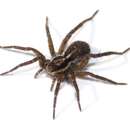Conservation Status
provided by University of Alberta Museums
Not at risk (COSEWIC, June 2005).
- license
- cc-by-nc
- copyright
- University of Alberta Museums
Cyclicity
provided by University of Alberta Museums
Adult males and females collected from April to July (Dondale & Redner, 1990).
- license
- cc-by-nc
- copyright
- University of Alberta Museums
Distribution
provided by University of Alberta Museums
Pardosa modica has been collected from the southern part of the Yukon Territory in Canada, east to Nova Scotia, and south to Connecticut in the United States (Dondale & Redner, 1990).
- license
- cc-by-nc
- copyright
- University of Alberta Museums
General Description
provided by University of Alberta Museums
Pardosa modica is similar to other Pardosa, with a brown carapace that has a broken light brown to yellow (Kronestedt, 1981), or reddish (Chamberlin, 1908), band down the middle, and continuous lateral bands of similar colour, which are wider in the female. There are also two light spots just behind the eyes. The sternum is dark brown with a light, but indistinct median stripe (Kronestedt, 1981), bordered by black lines (Chamberlin, 1908). The chelicerae are light brown to yellow with darker streaks. The abdomen is grayish brown on top and mottled on the sides, and has a row of irregular black marks along each side (Kronesdtedt, 1981). The underside may have no markings, or two dark lines running down the middle and converging at the end of the abdomen, and sometimes an additional dark line running down each side (Chamberlin, 1908). The legs are light brown and, unlike some Pardosa, do not have rings. Instead, the femora have light longitudinal streaks (Kronestedt, 1981). Males (length = 6.71 +/- 0.51 mm) are only slightly shorter than females (length = 6.93 +/- 0.45 mm), and female carapace width (2.27 +/- 0.22 mm) seems to be narrower than male carapace width (2.41 +/- 0.21 mm) (Dondale & Redner, 1990). Characteristics of the male palp and the female epigynum must be used to distinguish P. modica from the other Pardosa. The palp is distinguished by its stout terminal apophysis, with the conductor situated distal to the basal margin of the apical division, and by its small median apophysis. The epigynum is distinguished by its atrium, which is about as wide as long, and by its median septum, which has a short, narrowed anterior, with the anterior margins of the cavity sclerites extending anterolaterally (Dondale & Redner, 1990).
- license
- cc-by-nc
- copyright
- University of Alberta Museums
Habitat
provided by University of Alberta Museums
In Alberta collected near a pond in the Hay Lakes area in the central region of the province.
- license
- cc-by-nc
- copyright
- University of Alberta Museums
Life Cycle
provided by University of Alberta Museums
Likely produces more than one egg sac, and has a two-year life cycle in the northern part of its range, and a one-year life cycle in the southern part of its range (Pickavance, 2001).
- license
- cc-by-nc
- copyright
- University of Alberta Museums
Trophic Strategy
provided by University of Alberta Museums
Like other wolf spiders, Pardosa modica hunts actively, by pouncing on prey and holding it with its front legs, while mashing it up with its chelicerae (Gertsch, 1979), and is a general predator on arthropods, including insects and other spiders.
- license
- cc-by-nc
- copyright
- University of Alberta Museums
Pardosa modica: Brief Summary
provided by wikipedia EN
Pardosa modica is a species of wolf spider in the family Lycosidae. It is found in the United States and Canada.
- license
- cc-by-sa-3.0
- copyright
- Wikipedia authors and editors

